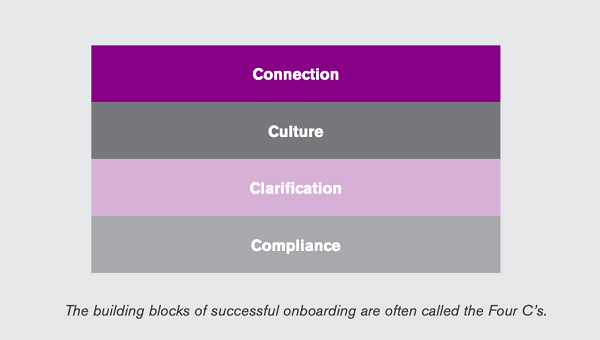New sales hires can be a valuable asset to your company. If you want your new employees to become productive team members, you must nurture them from the very beginning of the recruiting process.
This step-by-step guide aims to help you make sense of employee onboarding and ensure your new sales hires have the smoothest transition into your company.
What Exactly is Employee Onboarding?
Employee onboarding refers to the process through which new employees acquire the necessary skills and knowledge needed to become effective members of your team. Providing excellent employee onboarding is paramount for helping your new hires succeed.
Now, as you’ve covered the basics, here are the eight essential steps to onboarding new sales hires.
Step 1. Set Your Goals
Setting clear goals and expectations is the first step on the path to successful onboarding. By defining your goals, you can later evaluate the performance of your onboarding process. When it comes to onboarding sales hires, your new employees should have a clear understanding of what amount of sales they are expected to close in a specific period of time.
While each company has its own individual goals and expectations, there are four fundamental goals of the onboarding process:
- Help acclimate new sales hires to their job responsibilities.
- Create more employee engagement opportunities.
- Help new hires adapt to your corporate culture.
- Improve employee retention.
Step 2. Choose Which Type of Onboarding Suits Your Company Best
After setting clear goals, you must choose which type of onboarding suits you best. There are two main approaches to onboarding new sales hires – informal onboarding and formal onboarding.
Informal onboarding implies a semi-organized process through which new sales hires learn about their new job. Job shadowing, impromptu one-on-one coaching, meetings with management, and receiving equipment are some common examples of informal onboarding.
Formal onboarding refers to organized activities, such as step-by-step programs, designed to help new employees make sense of their role, duties, workplace norms, etc. In-class training, new hire orientation, and socialization activities are common examples of formal onboarding.
The formal process works better for onboarding sales hires as they need to adopt best sales practices that are proven to be effective in your company.
Step 3. Address Your Future Employees’ Needs and Expectations
To achieve successful onboarding, you must understand what your new sales hire needs and expects from you.
According to SHRM Foundation’s research, the guiding principles of your onboarding process should address the four distinct levels, also referred to as the Four C’s. Addressing these four levels is essential as they cover various needs your new sales hires have.
Connection. Helping new employees build vital interpersonal connections required for a successful workflow.
Culture. Providing new sales hires with a sense of organizational norms (both formal and informal).
Clarification. Making sure that all new employees understand their roles, jobs, and related expectations.
Compliance. Teaching new sales hires the basic policy-related rules and regulations of your corporation.
Step 4. Start Onboarding During The Recruiting Process
To get the most of your onboarding efforts, your onboarding process must begin during your recruiting phase. When conducting interviews, make sure to begin engaging your potential employees on the same four levels (connection, culture, clarification, and compliance).
Provide realistic insights into what the job is like during the recruiting phase to prevent new sales hires from suffering unmet expectations. By choosing the people who fit the culture of your organization you would ensure their smooth transition into the new roles. Moreover, sales hires are the people who communicate the most with your clients, so it’s important to choose individuals who correspond to the company’s values.
Don’t limit your resources when looking for employees. Take your time to find talented people.
Step 5. Don’t Rush The Training
When you’ve finally chosen your perfect candidates, take your time with the training process.
The first day (and sometimes a week) at any new job can be overwhelming. If you want to retain your quality sales hires, you must devote some time and effort to create the best day one possible. Also, it’s helpful to build a new employee welcome package to show your new hires they are valued in your company.
Step 6. Have new sales reps shadow senior reps
It’s hard to imagine the sales onboarding process without a job shadowing. Offer opportunities for your new sales reps to shadow senior representatives on sales calls.
Job shadowing at Salarship is a great opportunity for your newly hired sales representatives to learn about their new day-to-day responsibilities. Besides, it helps to make the onboarding process less confusing for sales reps as they get to see exactly what you are expecting from them.
Step 7. Introduce New Sales Hires to Your Corporate Culture
Studies show that more than 90% of employees highlight the importance of corporate culture at their firms. Having new sales hires embrace your corporate culture is essential for long-term success and employee retention.
Make sure to educate your new employees on the following aspects of the corporate culture for better onboarding:
- Politics of the workplace
- Company’s history
- Goals and values of your company
- Terminology and special language of the workplace
Additionally, you can use the Cultural Iceberg Model as a reference when deciding how to educate new employees on your corporate culture.
Source: https://www.personio.com/wp-content/uploads//2019/06/Iceberg-Model-.jpg
Step 8. Evaluate early performance
Evaluating the early performance of your newly hired sales reps will help you identify whether they meet expectations or not.
Most of the time, early performance is suffering due to the lack of proper onboarding. If you see that a sales representative doesn’t perform as well as expected, determine what else you can do to help them achieve the expected sales volume.
Step 9. Encourage Open Communication
Building connections with other team members is paramount for successful onboarding. Moreover, the quality of communication with peers is an integral part of employee retention, satisfaction, and your company’s overall performance.
Open communication with colleagues is especially important for sales hires and they get a chance to learn about best sales practices and ways to communicate with clients.
Step 10. Continue to Engage Employees
Employee onboarding is not a one-time event. Rather, it’s an ongoing and long-term process aimed to engage employees far beyond the first months of work in your company.
Employee engagement is paramount for long-term success. In fact, research suggests that highly engaged teams show 21% greater profitability.
Here are some tips for keeping your sales team members engaged:
- Continue to increase their knowledge and provide tools for improving their skills.
- Offer feedback tools and leverage employee feedback to improve the onboarding process.
- Invest in technology to maximize the productivity of your employees.
- Inspire open communication within your company.
Final thoughts
It’s important to have a standardized process for onboarding sales hires. Following each step of this guide will help you create a nurturing environment to ensure that your new sales representatives have everything they need to succeed!








Leave A Comment